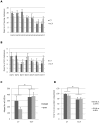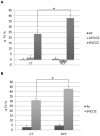Unstable maternal environment, separation anxiety, and heightened CO2 sensitivity induced by gene-by-environment interplay
- PMID: 21494633
- PMCID: PMC3072999
- DOI: 10.1371/journal.pone.0018637
Unstable maternal environment, separation anxiety, and heightened CO2 sensitivity induced by gene-by-environment interplay
Abstract
Background: In man, many different events implying childhood separation from caregivers/unstable parental environment are associated with heightened risk for panic disorder in adulthood. Twin data show that the occurrence of such events in childhood contributes to explaining the covariation between separation anxiety disorder, panic, and the related psychobiological trait of CO(2) hypersensitivity. We hypothesized that early interference with infant-mother interaction could moderate the interspecific trait of response to CO(2) through genetic control of sensitivity to the environment.
Methodology: Having spent the first 24 hours after birth with their biological mother, outbred NMRI mice were cross-fostered to adoptive mothers for the following 4 post-natal days. They were successively compared to normally-reared individuals for: number of ultrasonic vocalizations during isolation, respiratory physiology responses to normal air (20%O(2)), CO(2)-enriched air (6% CO(2)), hypoxic air (10%O(2)), and avoidance of CO(2)-enriched environments.
Results: Cross-fostered pups showed significantly more ultrasonic vocalizations, more pronounced hyperventilatory responses (larger tidal volume and minute volume increments) to CO(2)-enriched air and heightened aversion towards CO(2)-enriched environments, than normally-reared individuals. Enhanced tidal volume increment response to 6%CO(2) was present at 16-20, and 75-90 postnatal days, implying the trait's stability. Quantitative genetic analyses of unrelated individuals, sibs and half-sibs, showed that the genetic variance for tidal volume increment during 6%CO(2) breathing was significantly higher (Bartlett χ = 8.3, p = 0.004) among the cross-fostered than the normally-reared individuals, yielding heritability of 0.37 and 0.21 respectively. These results support a stress-diathesis model whereby the genetic influences underlying the response to 6%CO(2) increase their contribution in the presence of an environmental adversity. Maternal grooming/licking behaviour, and corticosterone basal levels were similar among cross-fostered and normally-reared individuals.
Conclusions: A mechanism of gene-by-environment interplay connects this form of early perturbation of infant-mother interaction, heightened CO(2) sensitivity and anxiety. Some non-inferential physiological measurements can enhance animal models of human neurodevelopmental anxiety disorders.
Conflict of interest statement
Figures




Similar articles
-
A genetically informed study of the association between childhood separation anxiety, sensitivity to CO(2), panic disorder, and the effect of childhood parental loss.Arch Gen Psychiatry. 2009 Jan;66(1):64-71. doi: 10.1001/archgenpsychiatry.2008.513. Arch Gen Psychiatry. 2009. PMID: 19124689
-
Differential carbon dioxide sensitivity in childhood anxiety disorders and nonill comparison group.Arch Gen Psychiatry. 2000 Oct;57(10):960-7. doi: 10.1001/archpsyc.57.10.960. Arch Gen Psychiatry. 2000. PMID: 11015814
-
Early-life risk factors for panic and separation anxiety disorder: insights and outstanding questions arising from human and animal studies of CO2 sensitivity.Neurosci Biobehav Rev. 2014 Oct;46 Pt 3:455-64. doi: 10.1016/j.neubiorev.2014.04.005. Epub 2014 May 2. Neurosci Biobehav Rev. 2014. PMID: 24793177 Review.
-
Histone Modifications in a Mouse Model of Early Adversities and Panic Disorder: Role for Asic1 and Neurodevelopmental Genes.Sci Rep. 2016 Apr 28;6:25131. doi: 10.1038/srep25131. Sci Rep. 2016. PMID: 27121911 Free PMC article.
-
A neurobiological framework of separation anxiety and related phenotypes.Eur Neuropsychopharmacol. 2020 Apr;33:45-57. doi: 10.1016/j.euroneuro.2020.01.009. Epub 2020 Feb 8. Eur Neuropsychopharmacol. 2020. PMID: 32046934 Review.
Cited by
-
Early life adversity affecting the attachment bond alters ventral tegmental area transcriptomic patterning and behavior almost exclusively in female mice.Neurobiol Stress. 2021 Oct 4;15:100406. doi: 10.1016/j.ynstr.2021.100406. eCollection 2021 Nov. Neurobiol Stress. 2021. PMID: 34660854 Free PMC article.
-
Neurobehavioral Alterations in a Genetic Murine Model of Feingold Syndrome 2.Behav Genet. 2015 Sep;45(5):547-59. doi: 10.1007/s10519-015-9724-8. Epub 2015 May 31. Behav Genet. 2015. PMID: 26026879 Free PMC article.
-
Can separation anxiety disorder escape its attachment to childhood?World Psychiatry. 2016 Jun;15(2):113-5. doi: 10.1002/wps.20336. World Psychiatry. 2016. PMID: 27265693 Free PMC article. No abstract available.
-
Stability of extemporaneously compounded amiloride nasal spray.PLoS One. 2020 Jul 10;15(7):e0232435. doi: 10.1371/journal.pone.0232435. eCollection 2020. PLoS One. 2020. PMID: 32649677 Free PMC article.
-
Erythropoietin and the use of a transgenic model of erythropoietin-deficient mice.Hypoxia (Auckl). 2016 Apr 7;4:29-39. doi: 10.2147/HP.S83540. eCollection 2016. Hypoxia (Auckl). 2016. PMID: 27800506 Free PMC article. Review.
References
-
- MacLean PD. Brain evolution relating to family, play, and the separation call. Arch Gen Psychiatry. 1985;42:405–417. - PubMed
-
- Battaglia M, Bertella S, Politi E, Bernardeschi L, Perna G, et al. Age at onset of panic disorder: influence of familial liability to the disease and of childhood separation anxiety disorder. Am J Psychiatry. 1995;152:1362–1364. - PubMed
-
- Klein RG. Is panic disorder associated with childhood separation anxiety disorder? Clin Neuropharmacol. 1995;18:S7–S14.
-
- Klein DF. False suffocation alarms, spontaneous panic, and related conditions. Arch Gen Psychiatry. 1993;50:306–317. - PubMed
-
- Pine DS, Klein RG, Coplan JD, Papp LA, Hoven CW, et al. Differential carbon dioxide sensitivity in childhood anxiety disorders and non ill comparison group. Arch Gen Psychiatry. 2000;57:960–967. - PubMed

